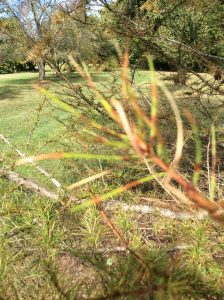Q. I have noticed lately that our three big, lovely larches are losing needles on their bottom half. The needles have a banded pattern of color, and I fear larch needle blight. How can I confirm or reject this hypothesis? Is there anything we can do to treat them? – JC
A. Specific diagnosis will require more than just these photos. I recommend sending samples of your trees to the Purdue Plant and Pest Diagnostic Lab. There is a small fee of $11, but a proper diagnosis can save you many more dollars in the long run. An appropriate treatment plan can then be advised based on an accurate diagnosis.
You can start with submission of digital images – the lab may request that you send in real samples of the trees, but there usually would not be an additional charge.
For more information and instructions for sample submission, see www.ppdl.purdue.edu.
Q. Attached is picture of a white ash. Leaves in the center are missing.
Also, trees in our area are also partially bare or completely bare after winter. Can anything be done to save them or is it permanent? – KA
A. There are a number of potential diseases/insect pests on white ash – like the previous question, diagnosis would require additional photos and possible real sample of the branches. One thing tree owners can do to determine potential for recovery would be to inspect a few of the affected twigs to look for live bark and buds – these would show green tissue when cut/scraped with a sharp knife. Dead buds and twig bark will be brown and likely dry and brittle. If portions of the twigs are dead, you can prune out the damaged branches by cutting back to healthier portions of the tree. For large trees, this may be a job best left to professional arborists.
For more information on hiring an arborist, see https://www.extension.purdue.edu/extmedia/fnr/fnr-faq-13-w.pdf from Purdue Forestry and Natural Resources.
Q. In an earlier column, you answered a question concerning an Egyptian tree or top-set onion. Several years ago, I had these plants, but eventually they died out. How could I get a start of them again? They were such a great source of green onions in the spring. – DM
A. Check with your local garden center. If they don’t already carry them, they may be able to order for you. Other names for these unusual onions include walking, potato, Egyptian and multiplier onions. Several retail online catalogs also list them including http://www.burpee.com/, www.jungseed.com, http://www.southernexposure.com and http://www.territorialseed.com.
You might also check with companies that specialize in heirloom varieties.

